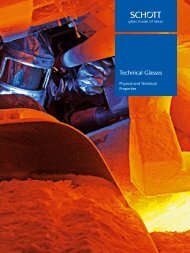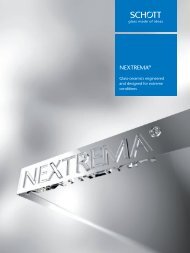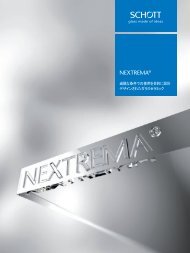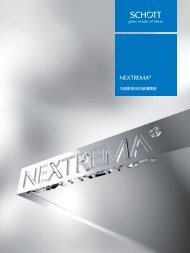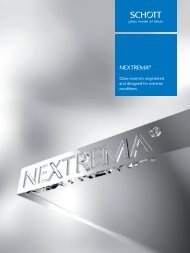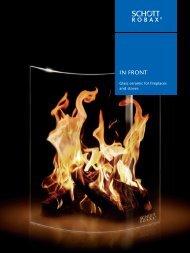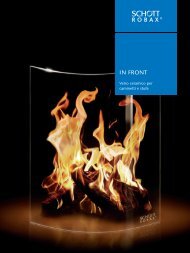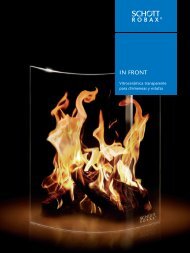Technology Magazine "SCHOTT solutions" Edition 2/2014
The SCHOTT solutions glass magazine features articles, reports and interviews on glass technological challenges from all over the world. The SCHOTT Technology Magazine. Beiträge, Reportagen und Interviews zu Lösungen von SCHOTT für technologische Herausforderungen weltweit.
The SCHOTT solutions glass magazine features articles, reports and interviews on glass technological challenges from all over the world.
The SCHOTT Technology Magazine. Beiträge, Reportagen und Interviews zu Lösungen von SCHOTT für technologische Herausforderungen weltweit.
Create successful ePaper yourself
Turn your PDF publications into a flip-book with our unique Google optimized e-Paper software.
Crystal clear: the glass sample to the right contains<br />
considerably fewer bubbles than the one on the left.<br />
These types of laboratory results ultimately form the<br />
basis for simulation programs and quality models.<br />
Glasklar: In der Glasprobe rechts sind deutlich weniger<br />
Blasen als links. Solche Laborergebnisse bilden<br />
letztlich eine Grundlage für Simulationsprogramme<br />
und Qualitätsmodelle.<br />
Photos Fotos : schott/ A. Sell<br />
ceramics, this means determining the number, size, and composition<br />
of the bubbles per kilogram that they still contain,”<br />
Dr. Berndhäuser explains and points to his colorful quality model<br />
on the screen. To forecast the quality in real tanks, the temperature<br />
distributions and flow pattern inside the tank are calculated using<br />
special cfd (Computational Fluid Dynamics) programs and are<br />
then assessed for the number of bubbles based on quality models<br />
developed in-house by the company. Laboratory trials inside a<br />
melting crucible make an important contribution to developing<br />
these models. They show the bubble size distribution depending<br />
on the refining agent used, its concentration, temperature and hold<br />
time for every type of glass analyzed. These parameters and values<br />
flow into the quality model and are transferred over to the actual<br />
size of the tank in the simulation.<br />
So-called tracers are now being used to describe how bubbles<br />
behave inside a tank. 100,000 of these simulated markers pass<br />
through the various modeled flow pattern and temperature zones<br />
on different paths, depending on the furnace design and setup.<br />
Statistics then provide information on the size and distribution of<br />
the bubbles during and at the end of the melting and refining<br />
process. “The next level of simulation will also include the bubbles’<br />
reactions to the refining process because the physical and chemical<br />
conditions change during the process, depending on the bubble<br />
load, ” Dr. Berndhäuser explains.<br />
These types of questions and insights also mark the starting<br />
point for optimized approaches to constructing and setting melting<br />
tanks, especially switching over to more environmentallyfriendly<br />
refining chemicals that don’t contain heavy metals.<br />
Research at schott is currently conducting an in-depth project<br />
on this topic. One thing is already clear: advances in the area of<br />
simulations definitely will not make it any easier to realize Einstein’s<br />
maxim on simplicity. <<br />
christoph.berndhaeuser@schott.com<br />
deutet auf sein buntes Qualitätsmodell auf dem Bildschirm. Für die<br />
Qualitätsprognose an realen Wannen werden die in der Wanne<br />
herrschenden Temperaturverteilungen und Strömungsformen mit<br />
speziellen cfd (Computational Fluid Dynamics)-Programmen berechnet<br />
und anschließend auf Basis der selbst entwickelten Qualitätsmodelle<br />
etwa hinsichtlich der Blasenzahl bewertet. Einen wesentlichen<br />
Beitrag für die Entwicklung der Modelle leisten reale<br />
Laborversuche im Schmelztiegel: Sie zeigen für jeden untersuchten<br />
Glastyp die Blasen(größen)verteilung in Abhängigkeit vom jeweils<br />
eingesetzten Läutermittel und dessen Konzentration sowie der<br />
Temperatur und Haltezeit. Diese Parameter und Werte fließen in<br />
das Qualitätsmodell ein und werden in der Simulation auf die<br />
reale Wannendimension übertragen.<br />
Um nun das Verhalten von Blasen in der Wanne zu beschreiben,<br />
kommen sogenannte Tracer zum Einsatz. 100.000 dieser simulierten<br />
Marker durchlaufen auf verschiedenen Pfaden die modellierten<br />
unterschiedlichen Strömungen und Temperaturzonen – je nach<br />
Anlagen-Design und -Setup. Eine Statistik dazu gibt dann Auskunft<br />
über die Blasengrößen, -verteilung und -last im und am<br />
Ende des Schmelz- bzw. Läuterprozesses. „Die nächste Simulationsstufe<br />
wird auch die Rückwirkung der Blasen auf den Läuterprozess<br />
einbeziehen. Denn je nach Blasenlast verändern sich auch die<br />
physikalischen und chemischen Bedingungen im Prozess“, so<br />
Dr. Berndhäuser.<br />
Solche Fragen und Erkenntnisse sind zugleich Ausgangspunkt<br />
für optimierte Konzepte der Schmelzwannen-Konstruktion und -Einstellung<br />
– insbesondere zur Umstellung auf eine umweltverträglichere<br />
Läuterchemie ohne Schwermetalle. Die schott Forschung<br />
führt dazu ein umfassendes Entwicklungsprojekt durch. Dabei ist<br />
eines schon sicher: Der Fortschritt der Simulation wird es nicht<br />
leichter machen, Einsteins Motto der Einfachheit umzusetzen. <<br />
christoph.berndhaeuser@schott.com<br />
33






